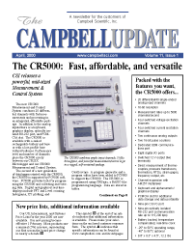CSI releases a powerful, mid-sized Measurement & Control System
The new CR5000 Measurement and Control System combines 20 differential channels with fast measurements and processing in an integrated, affordable package. In addition to the analog inputs there is a keyboard, graphics display, optically isolated RS-232 port, and PCMCIA slot. The CR5000 is available with a sealed rechargeable battery and base or with a low-profile base without batteries. Performance level and number of channels place the CR5000 nicely between our CR23X Micrologger and our CR9000 Measurement and Control System.
The second of a new generation of dataloggers started with the CR9000, the CR5000 is supported by PC9000 software. PC9000 provides tools for programming the CR5000 and collecting and viewing data. Digital and graphical real-time displays include FFT and Level crossing histograms, XY plotting, and Oscilloscope. A program generator and a program editor have been added to PC9000 to support the CR5000. The CR5000 is programmed using CRBasic, a BASIC-like programming language. Data are stored in tables.
The built-in keyboard and graphics display allows the user to check measurements, view and plot stored data, set program flags, change or format the PC card, and run or edit a stored program.
Two megabytes of internal, battery-backed SRAM are available for operating system use and data storage. Data storage is expanded via the built-in PCMCIA slot. The slot accepts one type I, type II or type III card (SRAM or ATA, DOS formatted). ATA FLASH cards greater than 200 Mbytes and type III hard disks exceeding 1 Gbyte are available. The hard disks have a reduced temperature and shock range. Data stored on the PC card can be collected from the CR5000 via a computer/telecommunications link or the card can be removed and read directly in a PC. Data buffered in the CR5000 while the card is removed are written to a card when it is inserted.
The CR5000 can measure and store up to 5000 measurements per second without a burst mode; for example, 20 channels measured and stored every 4 milliseconds. The overhead required to set up a scan reduces the throughput to 2000 Hz when measuring a single channel (0.5 milliseconds per scan).
For automotive testing applications, all analog channels and both pulse channels can be measured at a 100 Hz scan rate while using analog integration to reduce measurement noise. Considerable processing is possible at this rate.
In addition to the statistical output routines for collecting averages, maxima, minima, standard deviations, etc., routines are available that store only critical data or summaries. These include:
- Fast Fourier Transform
- Data Event starts and stops storing data based on trigger conditions. Data before the start trigger and following the stop trigger can also be stored
- Worst Case allows ranking the data events and keeping only the most significant ones
- Histograms include multidimensional frequency distribution, level crossing, and rainflow (stress/strain cycle counting for fatigue analysis)
The CR5000 can measure four separate eddy covariance H2O/CO2 surface flux systems at 20 Hz plus standard meteorological sensors, while calculating fluxes on line as well as storing the time series data.
If speed isn’t necessary, the CR5000 is as miserly with power as our other dataloggers. While measuring at 5 kHz it consumes 200 mA, but when the scan interval is longer, it drops considerably. At a 1 Hz scan rate the current averages 4.5 mA. At scans longer than 10 seconds, a sleep mode reduces the average current to 1.5 mA. The CR5000 can also power off under program control (0.4 mA) and wake up either at a preset time or in response to a digital input.
A new measurement feature is current excitation for resistance measurements. The current excitation, programmable in the range of ± 2.5 mA, allows measuring sensors such as RTDs directly without bridge completion resistors.
We are currently accepting orders for the CR5000 with a 60 day ARO delivery. Please check with a CSI applications engineer as to the suitability of the CR5000 for your application.

